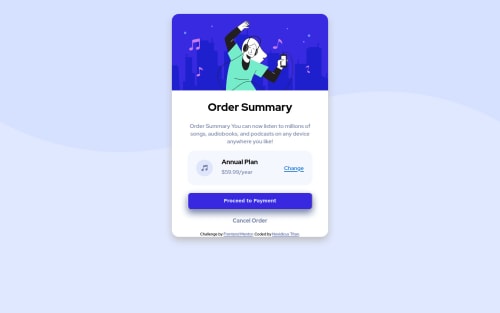first-project-responsive-order-summary-using-grid, only html & scss

Solution retrospective
I have made a video about how i did this project on my youtube chanel if you want to check it out, thanks
Please log in to post a comment
Log in with GitHubCommunity feedback
- @kens-visuals
Hey @NovidicusTitan 👋🏻
I've got some suggestions to help you fix the accessibility and HTML issues.
- In your markup,
<div class="">...</div>should be<main class="">...</main>and<div class="attribution">...</div>should be<footer class="attribution">...</footer>. - Next, you cannot nest
buttoninside<a>tag or vice versa. In this case you have to choose between one of them. - Next, I suggest using
<h2>or<p>instead of<h4>, because headings in HTML have to increase gradually, such ash1, h2, h3….. These will fix the accessibility and HTML issues. Don't forget to generate a new repot once you fix the issues. - For the music icon, add
aria-hidden="true”, because it's for decoration. You can read more aboutaria-hiddenhere. - Hero image should have a
display: block;, it removes the line underneath the image. If you want to know what's causing it, check out the 3rd section of this video. - Also, I suggest adding
transition: all 0.2s;to the button and the links, this will make:hoversmoother. - Lastly, I won't go into many details about resetting CSS, but I'll leave this cool article here, which will make more sense than my brief explanation.
I hope this was helpful 👨🏻💻 all in all, you did a good job for your first project, nicely done. Cheers 👾
Marked as helpful - In your markup,
- @sskhekhaliya
hey, I just looked at your site, there are some suggestions:
- There is no need to using
border-radius: 20px 20px 0px 0px;for image, instead of it just applyoverflow: hidden;to .container. So it will hide the corners of images also. - It will be good to give a little
padding-bottomto the card. - Card's
margin-top:40px;didn't make it vertically centered and if someone will see your site on the big screen then the card is not able to be vertically centered. So for it, you can usedisplay: flex;for body and then set its direction to column (flex-direction: column;) and give a height to the body 100vh.
Marked as helpful - There is no need to using
Join our Discord community
Join thousands of Frontend Mentor community members taking the challenges, sharing resources, helping each other, and chatting about all things front-end!
Join our Discord